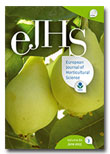


ISSN 1611-4426 print and 1611-4434 online | © ISHS 2015 | European Journal of Horticultural Science | Original article
Preliminary identification of pear accessions of 'Lubeničarka' group using RAPD markers
M. Kajkut1, G. Đurić1,2 and N. Mićić1,2
1 Genetic Resources Institute
2 Faculty of Agriculture
University of Banja Luka, Banja Luka, Republic of Srpska, Bosnia and Herzegovina
|
SUMMARY
The preliminary identification of six pear (Pyrus communis L.) accessions of the ‘Lubeničarka’ group in the collection of the Republic of Srpska Gene Bank was done in order to compare their genetic similarity. Pear accessions were analysed using Randomly Amplified Polymorphic DNA (RAPD) markers. Pear accessions of the ‘Lubeničarka’ group: ‘Lubeničarka’, ‘Lubeničarka Milići’, ‘Lubeničarka Zvornik’, ‘Lubeničarka Vlasenica’, ‘Krupna Lubeničarka’ and ‘Crna Lubeničarka’, were analyzed using eleven primers which amplified base pairs of the length between 400 and 2,000 bp. The obtained results showed that all accessions can be separated into two groups. The first group are accessions with the coefficient of similarity (1.0), namely ‘Lubeničarka’, ‘Crna Lubeničarka’, ‘Lubeničarka Milići’, ‘Lubeničarka Vlasenica’ and ‘Lubeničarka Zvornik’. Only one accession belongs to the second group, namely ‘Krupna Lubeničarka’ accession with genetic similarity coefficient of 0.6. Keywords field collection, genetic characterization, genetic similarity, germplasm, duplicates |
Significance of this study
What is already known on this subject?
|
|
|
|
E-mail: gordana.djuric@griunibl.rs.ba
References
- Bayazit, S., Imrak, B., Küden, A., and Kemal Güngör, M. (2011). RAPD analyses of genetic relatedness among selected quince (Cydonia oblonga Mill.) accessions from different parts of Turkey. Hort. Sci. (Prague) 38, 134–141.
- Beširević, V. (2009). Autohtone jabuke i kruške sa prostora Bosne i Hercegovine (Tuzla, Harfo-graf), 233.
- Botta, R., Akkak, A., Me, G., Radicati, L., and Casavecchia, V. (1998). Identification of pear cultivars by molecular markers. Acta Hort. 457, 63-70. https://doi.org/10.17660/ActaHortic.1998.457.7.
- Bruel, D.C., Carpentieri-Pipolo, V., Gerage, A.C., Fonseca Junior, S.N., Prete, C.E.C., Raus, F.C., Raus, P.M., Hulse De Souza, S.G., and Garbuglio, D.D. (2006). Genetic distance estimated by RAPD markers and its relationship with hybrid performance in maize. Pesquisa Agropecuária Brasileira 41, 1491–1498. https://doi.org/10.1590/s0100-204x2006001000006.
- Đurić, G., Tomić L., Mićić, N., Cvetković, M., Radoš, L.J., and Pašalić, B. (2009). Fruit genetic resources in Republika Srpska. Acta Agriculturae Serbica 28, 31–40.
- Đurić, G., Mićić, N., and Salkić, B. (2014). Evaluation of pear (Pyrus communis L.) germplasm collected in Bosnia and Herzegovina using some pomological and ecophysiological characteristics. Acta Hort. 1032, 105–115. https://doi.org/10.17660/ActaHortic.2014.1032.14.
- Jaccard, P. (1908). Nouvelles recherches sur la distribution florale. Bul. Soc. Vaudoise Sci. Nat. 44, 223–270.
- Kapteyn, J., and Simon, J.E. (2002). The Use of RAPDs for Assessment of Identity, Diversity, and Quality of Echinacea. In Trends in new crops and new uses, J. Janick and A. Whipkey (eds.) (Alexandria, VA, ASHS Press), pp. 509–513.
- Lin, J., Wang, X.C., and Chang, H.Y. (2011). Development of a novel and efficient strategy for practical identification of Pyrus spp. (Rosaceae) cultivars using RAPD fingerprints. Genet. Mol. Res. 10, 932–942. https://doi.org/10.4238/vol10-2gmr1097. PMid:21644210.
- Marinković, J., Đorđević, V., Balašević-Tubić, S., Bjelić, D., Vučelić-Radović, D., and Jošić, D. (2013). Osmotic stress tolerance, PGR traits and RAPD analysis of Bradyrhizobium japonicum. Genetika 45, 75–86. https://doi.org/10.2298/GENSR1301075M.
- Mićić, N., Đurić, G., and Salkić, B. (2012). Pomological characterisation of pear varieties of the ‘Lubeničarka’ group. Agro-Knowledge Journal 13, 15–30.
- Monte-Corvo, L., Cabrita, L., Oloveira, C., and Leitao, J. (2000). Assessment of genetic relationships among Pyrus species and cultivars using AFLP and RAPD markers. Genetic Resources and Crop Evolution 47, 257–265. https://doi.org/10.1023/A:1008794809807.
- Sadeghi, A., and Cheghamirza, K. (2012). Efficiency of RAPD and ISSR marker systems for studying genetic diversity in common bean (Phaseolus vulgaris L.) cultivars. Annals of Biological Research 3, 3267–3273. Available online at http://www.scholarsresearchlibrary.com.
- Sharma, P., Sharma, V., and Kumar, V. (2014). Genetic Diversity Analysis of Cluster Bean [Cyamopsis tetragonoloba (L.) Taub] Genotypes Using RAPD and ISSR Markers. J. Agr. Sci. Tech. 16, 433–443.
- Teng, Y., Tanabe, K., Tamur, F., and Itai, A. (2002). Genetic Relationships of Pyrus Species and Cultivars Native to East Asia Revealed by Random Amplified Polymorphic DNA Markers. J. Amer. Soc. Hort. Sci. 127, 262–270.
- Williams, J.G.K., Kubelik, A.R., Livak, K.J., Rafalski, J.A., and Tingey, S.V. (1990). DNA polymorphisms amplified by arbitrary primers are useful as genetic markers. Nucl. Acids Res. 18, 6531–6535. https://doi.org/10.1093/nar/18.22.6531. PMid:1979162 PMCid:PMC332606.
Received: 10 October 2014 | Revised: 9 January 2015 | Accepted: 6 March 2015 | Published: 17 June 2015 | Available online: 17 June 2015